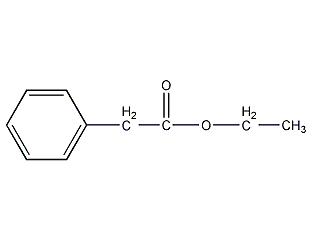
Structural formula
| Business number | 02LE |
|---|---|
| Molecular formula | C10H12O2 |
| Molecular weight | 164.20 |
| label |
Ethyl phenylacetate, Phenylacetic acid ethyl ester, Ethyl benzeneacetate, Edible spices |
Numbering system
CAS number:101-97-3
MDL number:MFCD00009178
EINECS number:202-993-8
RTECS number:AJ2824000
BRN number:509140
PubChem number:24887317
Physical property data
1. Properties: Colorless or nearly colorless transparent liquid with strong and sweet honey, rose and fruity aroma.
2. Boiling point (ºC, 101.3kPa): 226
3. Boiling point (ºC, 8.7kPa): 141~142
4. Boiling point (ºC ,4.3kPa): 135
5. Boiling point (ºC, 2.9kPa): 121
6. Boiling point (ºC, 1.3kPa): 100.5
7 . Boiling point (ºC, 0.01kPa): 67~69
8. Melting point (ºC): -29.4
9. Relative density (g/mL, 25/4ºC): 1.0277
10. Relative density (g/mL, 20/4ºC): 1.0333
11. Relative density (g/mL, 85/4ºC): 0.9743
12. Refractive index (25ºC): 1.498
13. Refractive index (20ºC): 1.4973
14. Flash point (ºC, closed): 77
15. Solubility: Miscible with ethanol, ether, benzene, and chloroform, but insoluble in water.
16. Boiling point (ºC): 227
Toxicological data
1. Acute toxicity: rat oral LD50: 3300mg/kg; 2. Mutagenicity: DNA repair test: Bacillus subtilis, 21mg/disc; 3. Irritating to eyes and skin, avoid inhalation of vapor.
Ecological data
This substance is slightly hazardous to water.
Molecular structure data
1. Molar refractive index: 46.84
2. Molar volume (cm3/mol): 158.7
3. Isotonic specific volume (90.2K ): 388.1
4. Surface tension (dyne/cm): 35.7
5. Dielectric constant:
6. Dipole moment (10-24cm3):
7. Polarizability: 18.56
Compute chemical data
1. Reference value for hydrophobic parameter calculation (XlogP): None
2. Number of hydrogen bond donors: 0
3. Number of hydrogen bond acceptors: 2
4. Number of rotatable chemical bonds: 4
5. Number of tautomers: none
6. Topological molecule polar surface area 26.3
7. Number of heavy atoms: 12
8. Surface charge: 0
9. Complexity: 137
10. SameThe number of isotopic atoms: 0
11. The number of determined atomic stereocenters: 0
12. The number of uncertain atomic stereocenters: 0
13. Determined number of stereocenters of chemical bonds: 0
14. Number of uncertain stereocenters of chemical bonds: 0
15. Number of covalent bond units: 1
Properties and stability
1. Avoid contact with strong oxidants. Colorless or nearly colorless transparent liquid with a strong and sweet honey aroma. Insoluble in water, miscible with organic solvents such as ethanol and ether. Avoid inhalation of vapors.
2. Found in flue-cured tobacco leaves.
3. Naturally found in honey, wheat bread, and cocoa.
Storage method
Store in a cool, ventilated warehouse. Keep away from fire and heat sources. should be kept away from oxidizer, do not store together. Equipped with the appropriate variety and quantity of fire equipment. Suitable materials should be available in the storage area to contain spills.
Synthesis method
1. Obtained from the reflux reaction of phenylacetonitrile, ethanol and sulfuric acid. Ethyl phenylacetate can also be obtained by esterification of phenylacetic acid and ethanol under the action of sulfuric acid, with a yield of 90%. Another production method is obtained by hydrolysis and esterification of phenylacetamide. There is also the phenylacetic acid method: obtained by the esterification of phenylacetic acid and ethanol.
2. Tobacco: FC, 18.
3. Preparation method:
In a reaction bottle equipped with a stirrer and a reflux condenser, add 155 mL of 95% ethanol, and slowly add 150 g of concentrated sulfuric acid while cooling in an ice-water bath. , then add 75g (0.64mol) of benzylnitrile (2), and heat to reflux with stirring for 8 hours. After cooling, pour into 400g ice water, separate the organic layer, add 75mL of diethyl ether, wash with saturated sodium bicarbonate solution, water, and dry over anhydrous calcium sulfate. Steam off the ether. The residue was continued to be distilled, and the fractions at 225-229°C were collected to obtain about 90g of ethyl phenylacetate (1), with a yield of 86%. [1]
4. Preparation method:
In a reaction flask equipped with a stirrer, thermometer and dropping funnel , add 0.2 mol of diphenylcadmium, 60 mL of dry THF, cool in an ice bath, and slowly add dropwise a solution of 16.7 g (0.1 mol) of ethyl bromoacetate (2) dissolved in 15 mL of THF while stirring. After the addition was completed, the reaction was continued to stir for 10 h in the ice bath. Add excess saturated aqueous ammonium chloride solution for hydrolysis. Steam distillation. Start collecting 150mL, which is mainly THF, and there is almost no residue after concentration. Collect another 400 mL as the second fraction. The final fraction does not contain carbonyl compounds but does contain biphenyl. The second fraction was extracted with diethyl ether and distilled under reduced pressure. The fraction at 66-71℃/80-133Pa was collected to obtain 8.6g of compound (1) with a yield of 53%. [2]
Purpose
1. This product is a synthetic fragrance with a distinct and sweet rose fragrance. It is widely used in the flavors of cigarettes, soaps, and daily cosmetics. A small amount is used in white roses, and a trace amount is used in the flavors of orange blossom, sweet beans, and honey fruits. It is suitable for Havana-type grass flavors. In the pharmaceutical industry, this product is used to produce the barbiturate hypnotic drug luminal, and can also be used as a solvent.
2. It can be used in food flavor formulations, mainly used to prepare honey-flavored and fruity flavors. It can also be used in tobacco flavor formulations.
3. Commonly used in baked goods, candies, and puddings.

 微信扫一扫打赏
微信扫一扫打赏

